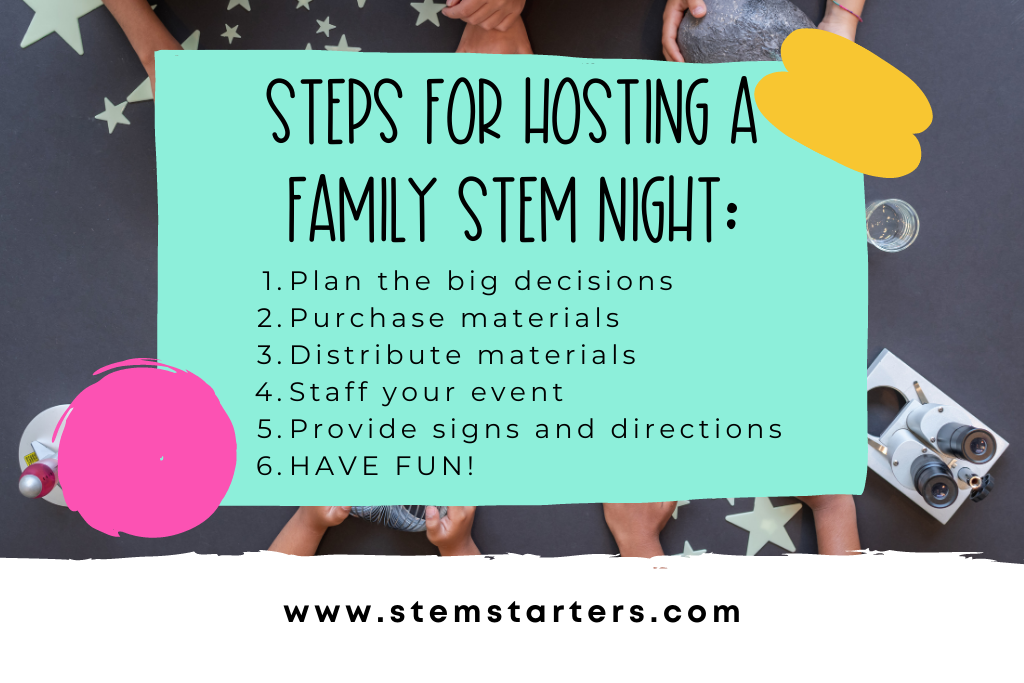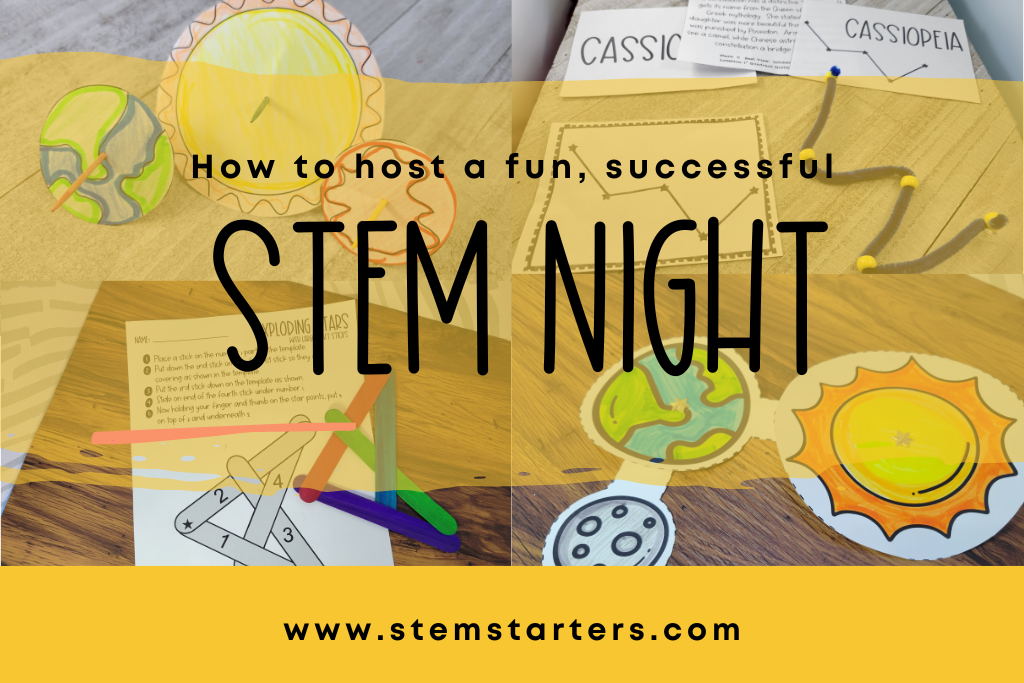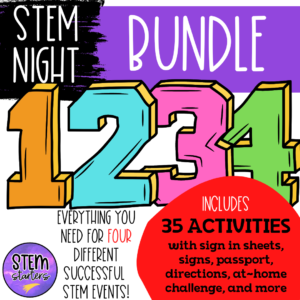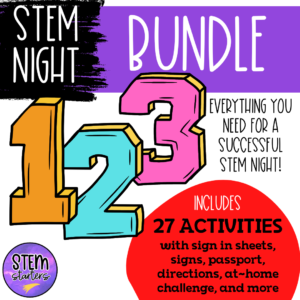A school-wide STEM Night is a wonderful way to engage your students AND their families in learning stations that are fun and guaranteed to be one of the most fun nights that your school hosts! Students will be begging for a STEM Night every year!
Readymade STEM Night
Does the thought of setting up for a STEM night at school sound overwhelming? I have you covered! In my STEM Night resources (I have 3 to choose from!), I have done all of the hard work for you. Everything is ready to go, you just need to:
- Print copies
- Buy materials
- Recruit station leaders
- Invite your families
If you have ideas for activities or want to use materials that you already have at your school, continue reading to get an idea about how to host a successful and engaging STEM Night for families.
Favorite Night of the Year
STEM Night has been an annual tradition for me for over nine years and it was our students’ favorite night of the year. Then the pandemic happened. We did not host a STEM Night that first year, but the next year I decided the pandemic wouldn’t take our STEM Night from us too! I did a complete pivot and created a VIRTUAL STEM Night for our families about outer space. Students had a blast and it brought back a little normal to our life.
Why host a STEM Night?
Students love hands-on learning and hosting a family STEM Night allows the entire family to get in on the learning. Parents can help their children complete the activities and explain the learning that is going on. Anyone can host a STEM night for their classroom or their whole school.
How to Host a STEM Night

1. Plan your STEM Night
There are several things that you need to think about while planning your STEM Night for students. Make sure to think them all through.
Activities and location
I usually have 6-10 activities that are quick science/STEM-based activities, such as this hoop glider. I have also invited in community partners in the past such as local universities, high schools, or companies to host a station. For example, the police department came out to show students how to put their fingerprint on a balloon and blow it up to look at the swirls and whirls larger. We host our night at the school and usually have another event such as PTA or dinner happening simultaneously to get more families involved.
Virtual or In-person
We host an in-person event as much as possible, but for the last two years, our STEM Family Night has been virtual. For a virtual night, we divided the materials for six different stations into plastic bags and sent them home with students. They logged in to the main Google Meet. I explained how the night would work and gave everyone a link to copy for a Google Slides “passport.” Students were able to log in to different Google Meet links for each activity and those were already available on their passports.
With an in-person event, you usually have more participation and excitement, but it also takes more people to run each station. There are pros and cons to each!
Outside or Inside?
If it is nice weather where you are, you can make sure that each station can be housed at one or two tables. That way, you can set up tables for students to cycle through and have a STEM Carnival.
One Room or Several
I usually host my STEM Night throughout the school building and let each grade level host 2 -3 events. This helps with volunteer participation from staff. This also allows the event to be spread out because it is usually packed with students! You can also host the event in one large room, such as a gym. This is helpful if you are doing a school-wide event during the day and students have different times to attend.
STEM Night Volunteers
How will you staff your STEM Family night? Will you ask parents to sign up for a time? Will you have teachers that are “volun-told” that they need to run a station? Will you have community help? I work at a Title One school and we do not have enough community volunteers to pull off a large STEM Night. We usually have our teachers sign up for a station.
Day or Night
Will you host your event during the day or at night? If you host one during the day, you will possibly need many more materials than if you host at night. Out of 550 students, we usually have about 200 attend when it is held at night. If you host one during the day, school-wide you would need to provide enough materials for every student.
2. Purchase materials. What materials will you need for each station?
After you have planned the activities you are going to complete with students, you need to decide what materials you will need. Start by listing out what you need for each station, and then write what is needed for each student. Decide how many students you think will attend your event, or if it is during the school day how many total students you have and buy enough materials for everyone.
3. Distribute Materials
When I had my STEM event at night, I divided the materials out for each station into tubs from the dollar store. Teachers took these tubs, along with directions for each event to their classrooms for the event. If you were hosting your STEM event in one big room or outside with each event being at a table, you can distribute materials in tubs as well.
When we had our virtual night, we sent home materials with each student so they could be prepared to attend. When I did this, I laid out all materials on a table with signs telling volunteers how many of each item was needed for the bag. Volunteers then packed grocery bags of all the materials to send home with students. I did not send directions home with students before the event so they would be encouraged to attend, but then I sent directions school-wide after the night in case they were unable to make it to the live virtual event.
4. Staff Your Event
There are many ways that you can staff your event. Parents, high schools, local churches, community members, and even teachers at your school are all options for helping to run each station. I made a sign up sheet using Google Sheets, but you can also use an online program, such as Sign-up Genius, to gather volunteer information. I usually had at least two volunteers for each station, but the more intensive the station, the more volunteers I would schedule. With our STEM Night, it was required attendance for teachers so I had them completely staff our event. You can also reach out to STEM professionals in your community, especially if you are at a school where parents in STEM careers are abundant. Parents in your school are also an option to run all stations, but if you decide to go with this one, I would consider having parents sign up in shifts so they can still go around the event with their own child.
5. Provide Signs and Directions
Directions are very important to provide. I always post these directions in both English and Spanish so my families are able to help their own child with the task. The volunteer is there to demonstrate, answer questions, and explain the science, but the parents can help their actual child complete the task. I think it is also important to have a finished product available for students and families to see as an example.
6. HAVE FUN!
This is the easiest step! STEM is always fun and you will love seeing your students (and their families) having such a blast. It makes all the hard work worth it in the end.
If you need help with what activities to host, check out my 4 available STEM Nights and all the activity planning is done for you!
Have you ever hosted a STEM Night? What would you add to the to-do list?













One Response
I am hosting an event at my school and would love some ideas.